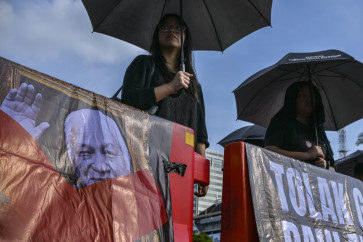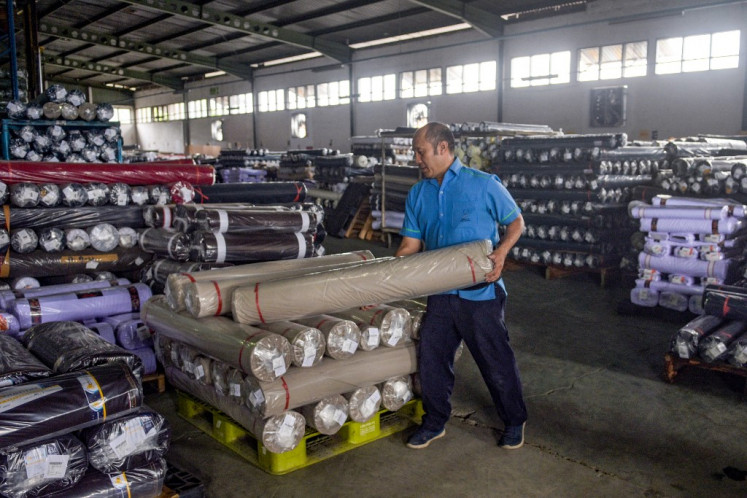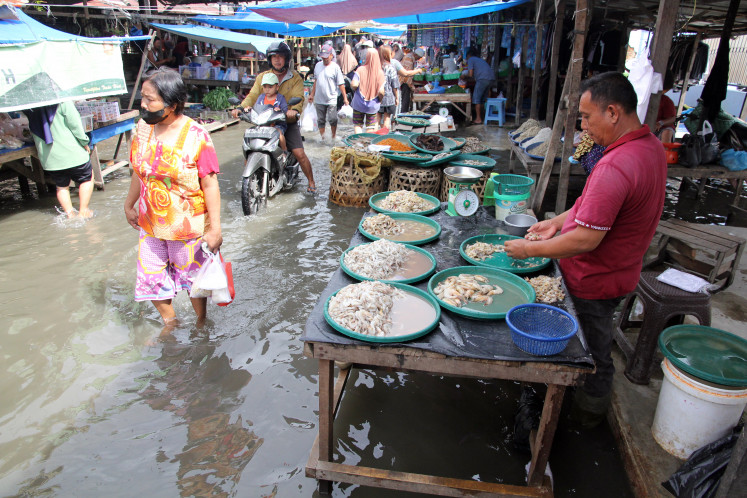Popular Reads
Top Results
Can't find what you're looking for?
View all search resultsPopular Reads
Top Results
Can't find what you're looking for?
View all search resultsPoland & Indonesia encounter
Letters for Change: Activists carrying works of Iza Rutkowska during their routine silent march Kamisan, which calls for investigations into a range of alleged human rights abuses
Change text size
Gift Premium Articles
to Anyone
Letters for Change: Activists carrying works of Iza Rutkowska during their routine silent march Kamisan, which calls for investigations into a range of alleged human rights abuses. (Courtesy of National Gallery)
Good design is […] a sequence of steps that defines problems, discovers solutions and makes them real (Design Council, 2008).
In recent years, we’ve begun to see an influx of cultural exhibitions showcasing foreign artwork and historical artifacts from other countries.
Amid this inter-country art-based cultural exchange, there are Polish curators Marianna Dobkowska and Krzysztof Lukomski, who organize “Social Design for Social Living,” an ongoing art exhibition at the National Gallery in Jakarta.
The two curators refused to be held back by cultural differences between countries and have realized the unimaginable; bringing together two distant cultures to produce extraordinary artworks with earth-shaking stories.
“There are no boundaries on who we work with. We found a common language and we’re attracted by the locals,” Dobkowska explained, discussing why she chose to work in Indonesia.

Clay Men of Jatisari: Another work from Kusmirowski. (JP/Christophorus Kevin Santoso)
This exhibition is more than just an art fair; it questions how one should organize an art exhibition. “Social Design for Social Living” is not merely about showcasing artwork by contemporary Polish artists in the form of paintings and sculptures. It is a living library full of Cinderella-like stories of the well-off helping the oppressed.
Thus, instead of merely bringing Polish artworks to Indonesia and showcasing them at the gallery, Dobkowska and Lukomski went the extra mile.
They brought Polish artists and threw them into an active real-life learning space in a small village called Jatisari in West Java.
There, the artists worked closely with Jatiwangi Art Factory to boost Jatisari to become one of the world’s clay production powerhouses, a local industry that has recently been overshadowed by the construction of large-scale textile production plants.
Marta Frank, one of the Polish artists invited to participate in the exhibition, devised a project called “Sabun Tanah” (the soap of the earth).
The exhibition guidebook states that Frank worked together with the factory to produce soap that will soon be sold to the general public. Prototypes from the soap project can be found at the gallery.
“I want people to understand that an artistic object can also be a cosmetic product worth buying,” Dobkowska said of Frank’s project.
Another standout of this exhibition is the series of workshops, meetings, art-talks and activities run by the Social Design Academy, the exhibition host.
The workshops involve topics such as collaboration, urban activism, non-violent resistance and alternative economies. All workshops are run by Social Design Academy members. Members of the Social Design Academy can also be found hovering throughout the gallery should you have questions.
Eka, a member of Social Design Academy, said he really admired the Polish artists.
“They are really nice people. They really respect us. I’ve never experienced such thing before,” he said.

Appreciation: Visitors enjoy the artwork displayed at the exhibition. (Courtesy of National Gallery)
Artist Iza Rutkowska puts up the same set of inflated letters used by activists and members of Social Design Academy every Thursday during Kamisan, a weekly silent protest outside the Presidential Palace that calls for investigation into a range of alleged human rights abuses. The artist, who’s been working closely with LBH (Legal Aid Institute), is hoping that this project will help those being silenced.
Robert Kuśmirowski’s “MonuMen” has drawn most of the attention; a series of black and white photographs incorporating clay and residents of Jatisari as one unified object. The choice to use black and white film stock adds a measure of sadness and sorrow to the work.
This exhibition comes across as a showroom of good design and the curators have emphasized the importance of this exhibition as a stepping stone for their future projects.
“This is just the third stage of our ongoing project. We’ll be starting a new project soon in Lombok where we’ll run workshops and events for the growing local community there,” Dobkowska said.
She also hoped that the curatorial team could exhibit past and future work in Krakow, Poland, next year.
----------------
Social Design for Social Living
29 June – 1 July 2016 and 12 – 26 July 2016
Exhibit opens from 10 a.m. till 8 p.m.
Building A, National Gallery Indonesia
_____________
The writer is an intern at The Jakarta Post










